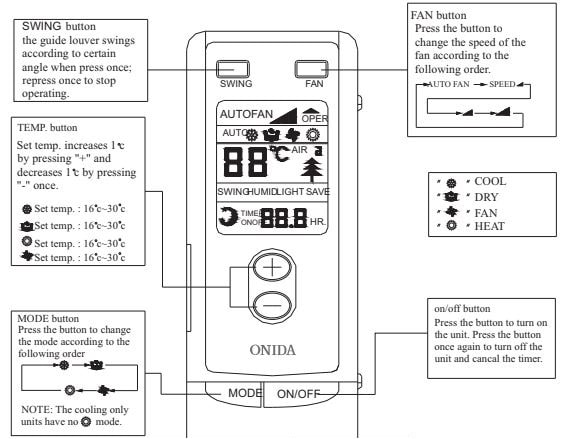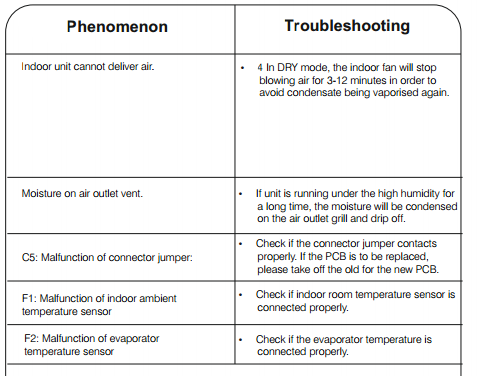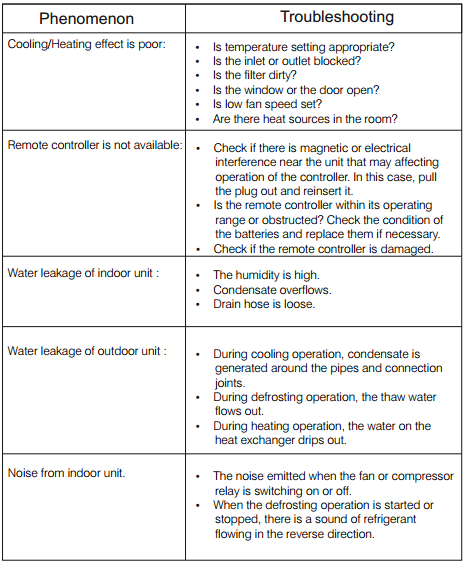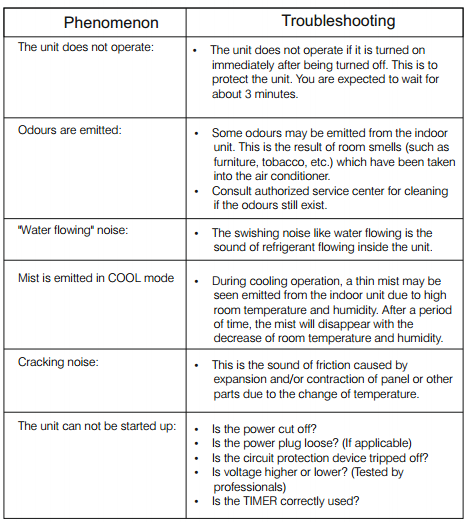When the controller displays malfunction,please turn off the unit to stop the malfunction display,ask for the professional to debug.

The meaning of error codes as shown in below:
| Error Codes | Meaning |
|---|---|
| E1 | High pressure protection of compressor |
| E2 | Indoor anti-frozen protection |
| E3 | Low pressure protection of compressor |
| E4 | Discharge temp. protection of compressor |
| E5 | Compressor overload protection |
| E6 | Transmit malfunction |
| E7 | Modes conflict |
| F0 | Indoor environment temp. sensor mal-function |
| F1 | Indoor pan tube inlet tube temp. sensor malfunction |
| F2 | Indoor pan tube middle temp. sensor malfunction |
| F3 | Indoor pane tube outlet tube temp. sensor malfunction |
| F4 | Outdoor environment temp. sensor malfunction |
| F5 | Outdoor pan tube inlet tube temp. sensor malfunction |
| F6 | Outdoor pan tube middle temp. sensor malfunction |
| F7 | Outdoor pan tube outlet tube temp. sensor malfunction |
| F8 | Discharge temp. sensor 1 (rated frequency) malfunction |
| F9 | Discharge temp. sensor 2 (digital) malfunction |
| FA | Greasy temp. temp. sensor 1 (rated frequency) malfunction |
| Fb | Greasy temp. temp. sensor 2 (digital) malfunction |
| FC | High pressure sensor malfunction |
| Fd | Low pressure sensor malfunction |

Troubleshooting
Phenomenon: C5 Malfunction of connector jumper
Troubleshooting: Check if the connector jumper contacts properly. If the PCB is to be replaced, please take off the old for the new PCB.
Phenomenon: F1 Malfunction of indoor ambient temperature sensor
Troubleshooting: Check if indoor room temperature sensor is connected properly.
Phenomenon: F2 Malfunction of evaporator temperature sensor
Troubleshooting: Check if the evaporator temperature is connected properly.
Phenomenon: The unit does not operate
Troubleshooting: The unit does not operate if it is turned on immediately after being turned off. This is to protect the unit. You are expected to wait for about 3 minutes.
Phenomenon: Odours are emitted
Troubleshooting:
- Some odours may be emitted from the indoor unit. This is the result of room smells (such as furniture, tobacco, etc.) which have been taken into the air conditioner.
- Consult authorized service center for cleaning if the odours still exist.
Phenomenon: “Water flowing” noise
Troubleshooting: The swishing noise like water flowing is the sound of refrigerant flowing inside the unit.
Phenomenon: Mist is emitted in COOL mode
Troubleshooting: During cooling operation, a thin mist may be seen emitted from the indoor unit due to high room temperature and humidity. After a period of time, the mist will disappear with the decrease of room temperature and humidity.
Phenomenon: Cracking noise
Troubleshooting: This is the sound of friction caused by expansion and/or contraction of panel or other parts due to the change of temperature.
Phenomenon: The unit can not be started up
Troubleshooting:
- Is the power cut off?
- Is the power plug loose? (If applicable)
- Is the circuit protection device tripped off?
- Is voltage higher or lower? (Tested by professionals)
- Is the TIMER correctly used?
Phenomenon: Cooling/Heating effect is poor
Troubleshooting:
- Is temperature setting appropriate?
- Is the inlet or outlet blocked?
- Is the filter dirty?
- Is the window or the door open?
- Is low fan speed set?
- Are there heat sources in the room?
Phenomenon: Remote controller is not available
Troubleshooting:
- Check if there is magnetic or electrical interference near the unit that may affecting operation of the controller. In this case, pull the plug out and reinsert it.
- Is the remote controller within its operating range or obstructed? Check the condition of the batteries and replace them if necessary.
- Check if the remote controller is damaged.
Phenomenon: Water leakage of indoor unit
Troubleshooting:
- The humidity is high.
- Condensate overflows.
- Drain hose is loose.
Phenomenon: Water leakage of outdoor unit
Troubleshooting:
- During cooling operation, condensate is generated around the pipes and connection joints.
- During defrosting operation, the thaw water flows out.
- During heating operation, the water on the heat exchanger drips out.
Phenomenon: Noise from indoor unit
Troubleshooting:
- The noise emitted when the fan or compressor relay is switching on or off.
- When the defrosting operation is started or stopped, there is a sound of refrigerant flowing in the reverse direction.
Phenomenon: Indoor unit cannot deliver air
Troubleshooting: 4 In DRY mode, the indoor fan will stop blowing air for 3-12 minutes in order to avoid condensate being vaporised again.
Phenomenon: Moisture on air outlet vent
Troubleshooting: If unit is running under the high humidity for a long time, the moisture will be condensed on the air outlet grill and drip off.
Model: INV18SLU-C8/INV18SLU-R8/INV18SLU-S8



Comments